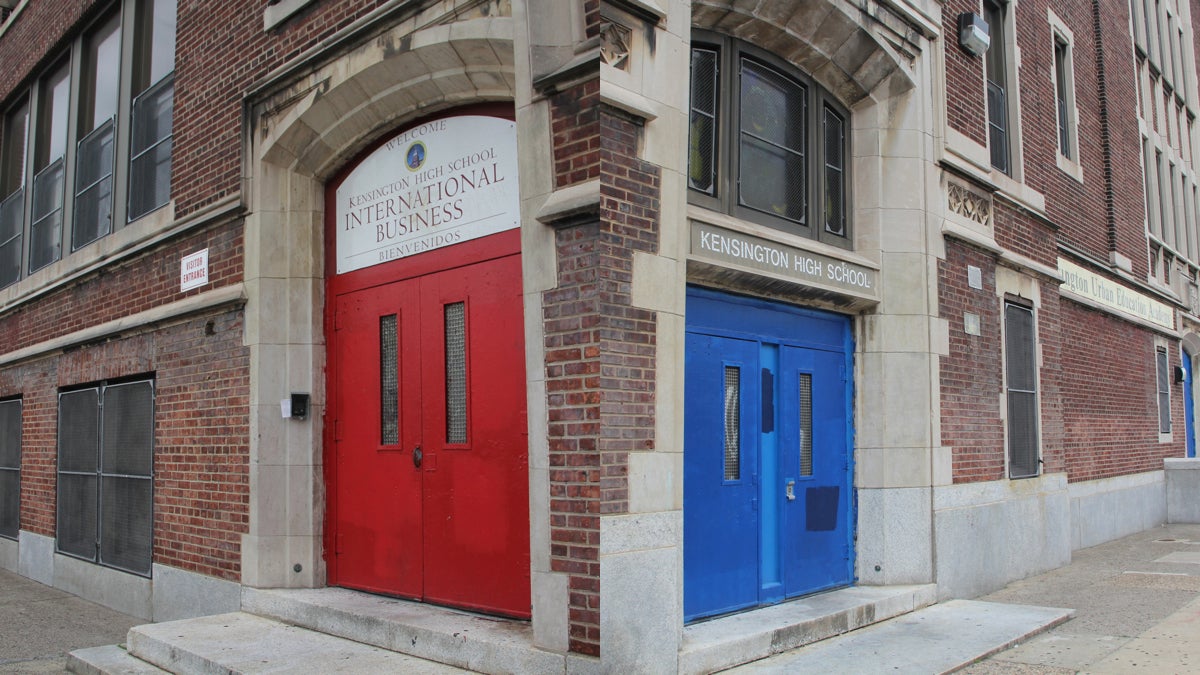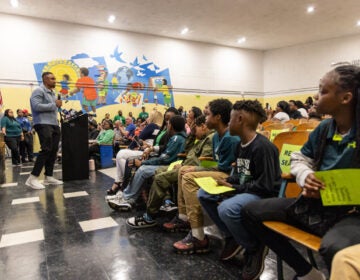In Kensington, concerns and ‘nuanced’ case for merging two low-performing public schools
Listen
Kensington High School for International Business and Kesington Urban Education Academy occupy the same building, the former Kensington High School. The district plans to begin merging the two schools in the fall. (Emma Lee/WHYY)
In the old Kensington High School building, two distinct schools have their own budgets, principals and classes. There’s even a physical barrier, a kind of wall between the two spaces.
Essence Whiting, a rising sophomore at one of the schools, Kensington Urban Education Academy, said there are doors in the wall, but students stay on their own sides. She said she prefers Kensington Urban — which has just over 300 students — and relationships she has at the smaller school over her old middle school, where the grades were three times as large.
“I know most of the teachers at my current school, and I know the principal, I know the secretaries, I know some of the lunch ladies,” said Essence.
Community and activist groups lobbied for a decade to turn some of Philadelphia’s large neighborhood high schools — including Kensington High School — into smaller schools.In 2008, activists got their wish. Kensington High became four small schools, each with a different academic focus, known collectively as the Kensington Multiplex.
This March, the School District of Philadelphia announced it would reunite two of those schools, prompting an outcry from students and some teachers.
Still, the district stands by its “nuanced” case for merging the schools. While support for the small schools movement bottomed out due to turnover at the superintendent level, the district still runs small schools of many different stripes — and many different levels of success.
The historical case for small schools
Neighborhood schools in big cities face many challenges, according to Rebecca Reumann-Moore, senior research associate with Research for Action, a group that followed schools during the small schools movement of the mid-2000s.
Unlike magnet or charter schools, neighborhood schools have to accept any student from a designated geographic area. That can concentrate students in poverty, English-language learners and students with special needs in neighborhood schools, Reumann-Moore said.
As a result, these schools tend to have lower graduation rates and test scores that are “quite low, especially compared to other high schools with admission standards,” she said.
Poor achievement at large neighborhood schools — such as Kensington, Olney and West Philadelphia high schools — combined with new information about dropout rates in these schools added fuel to the fire for smaller schools under former Philadelphia Superintendent Paul Vallas.
Vallas supported the creation of 25 small schools, each with no more than 700 students but most with fewer than 500. Some schools were newly created magnet schools with admissions standards, while others were carved out of existing neighborhood schools and accepted all students.
According to assistant superintendent Cheryl Logan, who oversaw the Kensington Multiplex starting in 2014, two of the schools have “flourished” — Kensington Creative and Performing Arts, or KCAPA, and Kensington Health Sciences. The other two — Kensington Urban Education Academy and Kensington International Business — have had a harder time attracting students, she said.
“If we didn’t place kids in that school, there would not be kids in that school,” said Logan about Kensington Urban.
In the district’s high school selection process, she said, students in the Kensington catchment routinely put Urban and Business as their fourth and fifth choices, after the other two Kensington schools and usually a career and technical program in another part of the city.
The knocks against small schools
Difficulty recruiting students was one factor in the merger of Kensington Urban and Kensington Business. In general, research on the effect of small schools has been mixed, showing significant gains in school climate but an inconclusive effect on academic performance.
Research for Action followed several categories of small schools that started under Vallas, and found that across categories — such as neighborhood and special admissions schools — students in small schools were more likely to pass Algebra I and less likely to be suspended. There were qualitative benefits too, according to Reumann-Moore.
Students feel “they’re known, that teachers were looking out for them, that teachers care for them, and that was true across admissions categories,” she said. Teachers also reported benefits, such as more professional trust and more opportunities to collaborate.
Academic rigor, though, was harder to measure. Reumann-Moore and her colleagues found no impact on truancy across categories of small schools.
Overall, local research on these schools is still sparse. In Philadelphia, as interest in small schools dried up, so did research dollars. But some newer research out of New York City shows long-term success. In one study, students randomly placed in small high schools showed a 9 percent gain in graduation rates and 8 percent gain in college enrollment over those placed in larger schools, according to a report released by nonpartisan education and social policy research group MDRC in 2014.
“Those findings were quite striking,” said Reumann-Moore. “It’s especially striking that these were schools that served mostly disadvantaged students of color and were seeing very positive results.”
Among the four Kensington High schools, KCAPA has seen the largest improvements in its graduation rate. None of the four is ranked well academically.
According to Logan, optics and leadership played large roles in the district’s decision to merge Urban and Business, which have the lowest scores of the four schools.
Urban has had the hardest time shaking an unsafe image, she said. “When you look at the [safety] data it’s not remarkably different,” between the four schools. “That’s really a perception.”
Perception helped drive down recruitment, as did a lack of school leadership. While leaders at Kensington CAPA and Health Sciences helped craft an attractive focus for students and draw in community partners, longtime Urban Principal Michelle Burns was one of three principals fired in 2014 in the fallout of a districtwide standardized cheating scandal.
Logan said the district considered closing the schools, but decided that there were “really good things on the Kensington Business side … things worth saving,” namely some career and technical courses and a club called DECA. The merged schools will get an infusion of money to start new courses, including a computer coding and repair CTE stream and an honors program.
“There was no cost savings in this merger,” said Logan. “None.”
She said the district supports its existing small schools, such as the Science Leadership Academy, but small is not always better.
“You can have a school with 100 students, and 25 of them are hanging out in the hallway,” said Logan, who pointed out the landscape of small schools has changed since the small schools push a decade ago. There are now many small charter and magnet schools, making a comparison of their metrics difficulty.
A complicated case
Still, the case for merging the two lowest-performing Kensington high schools is a complicated one, she said.
“I wouldn’t say that the district is moving away from small schools. I think it’s a very nuanced argument in this case to advocate for merging of the two, and it may seem counterintuitive,” said Logan.
The other option, according to Logan, was shutting the schools down. That’s exactly what student Essence Whiting is worried about.
“I feel like they would close it down for reasons of test scores,” she said. Her ultimate fear, she said, is “there would just be nowhere for the kids to go.”
Bowing to pressure from students, parents and teachers, Superintendent William Hite sent a letter to families saying the merger has been postponed until 2016.
However, starting in the fall, both schools will share one principal and joint programs.
WHYY is your source for fact-based, in-depth journalism and information. As a nonprofit organization, we rely on financial support from readers like you. Please give today.




